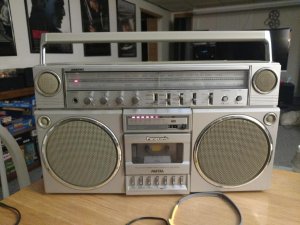Hi all.
Proud new owner of a pretty clean 5150 that I bought untested, but was advertised as "worked when plugged in". (I probably shouldn't say what I paid for it
I gave it a wipedown and plugged it in, and it made a horrendous screeching noise in Tape and Radio mode (not line-in) even with volume all the way down.
I plugged in a set of 'phones and it still screeched, so I started giving all controls a workout. The screeching subsided and music started to play, but the left channel is VERY weak, through the speakers and the headphones, when listening to radio or line-in (I'm afraid to try the tape deck).
Since it's both speakers and 'phones, is it more likely a dirty pot, or a bad amp? For what it's worth, the controls are all very quiet when I move them around, and I cycled the record bar (via the front control button) about 10 times with no change.
I can open it up and clean stuff if needed, but would rather have a specific goal than just go fishing and screw up my new find (I've read some of the nightmare stories of broken tuner strings, etc).
Rob
Proud new owner of a pretty clean 5150 that I bought untested, but was advertised as "worked when plugged in". (I probably shouldn't say what I paid for it

I gave it a wipedown and plugged it in, and it made a horrendous screeching noise in Tape and Radio mode (not line-in) even with volume all the way down.
I plugged in a set of 'phones and it still screeched, so I started giving all controls a workout. The screeching subsided and music started to play, but the left channel is VERY weak, through the speakers and the headphones, when listening to radio or line-in (I'm afraid to try the tape deck).
Since it's both speakers and 'phones, is it more likely a dirty pot, or a bad amp? For what it's worth, the controls are all very quiet when I move them around, and I cycled the record bar (via the front control button) about 10 times with no change.
I can open it up and clean stuff if needed, but would rather have a specific goal than just go fishing and screw up my new find (I've read some of the nightmare stories of broken tuner strings, etc).
Rob
Attachments
-
110.2 KB Views: 7



